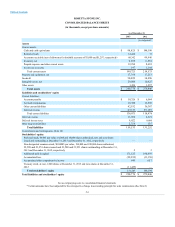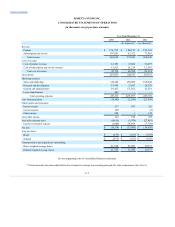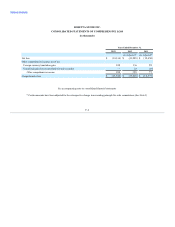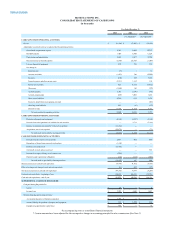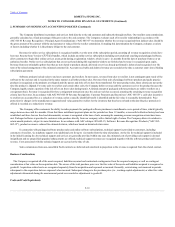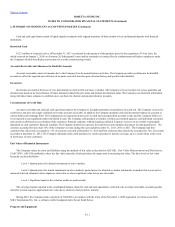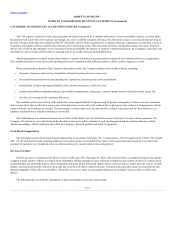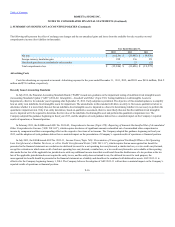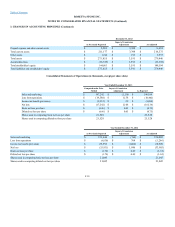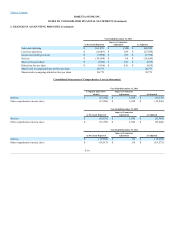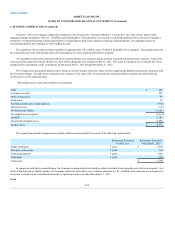Rosetta Stone 2013 Annual Report Download - page 76
Download and view the complete annual report
Please find page 76 of the 2013 Rosetta Stone annual report below. You can navigate through the pages in the report by either clicking on the pages listed below, or by using the keyword search tool below to find specific information within the annual report.
Table of Contents
Property and equipment are stated at cost, less accumulated depreciation. Depreciation on property, leasehold improvements, equipment, and software is
computed on a straight-line basis over the estimated useful lives of the assets, as follows:
Software
3 years
Computer equipment
3-5 years
Automobiles
5 years
Furniture and equipment
5-7 years
Building
39 years
Building improvements
15 years
Leasehold improvements
lesser of lease term or economic life
Assets under capital leases
lesser of lease term or economic life
Expenses for repairs and maintenance that do not extend the life of equipment are charged to expense as incurred. Expenses for major renewals and
betterments, which significantly extend the useful lives of existing property and equipment, are capitalized and depreciated. Upon retirement or disposition of
property and equipment, the cost and related accumulated depreciation are removed from the accounts and any resulting gain or loss is recognized.
In accordance with ASC topic 360, ("ASC 360"), the Company evaluates the recoverability of its long-lived assets.
ASC 360 requires recognition of impairment of long-lived assets in the event that the net book value of such assets exceeds the future undiscounted net cash
flows attributable to such assets. Impairment, if any, is recognized in the period of identification to the extent the carrying amount of an asset exceeds the fair
value of such asset. Based on its analysis, the Company believes that no impairment of its long-lived assets was indicated as of December 31, 2013 and 2012.
Intangible assets consist of acquired technology, including developed and core technology, customer related assets, trade name and trademark, and other
intangible assets. Those intangible assets with finite lives are recorded at cost and amortized on a straight line basis over their expected lives in accordance with
ASC topic 350, ("ASC 350"). Annually, as of December 31, and more frequently if a triggering event occurs, the
Company reviews its indefinite lived intangible assets for impairment in accordance with ASC 350. This guidance provides the option to first assess
qualitative factors to determine whether it is more likely than not that an indefinite-lived intangible asset is impaired as a basis for determining whether it is
necessary to perform the quantitative test. If necessary, the quantitative test is performed by comparing the fair value of indefinite lived intangible assets to the
carrying value. In the event the carrying value exceeds the fair value of the assets, the assets are written down to their fair value. There has been no impairment
of intangible assets during any of the periods presented.
Goodwill represents purchase consideration paid in a business combination that exceeds the values assigned to the net assets of acquired businesses.
The Company tests goodwill for impairment annually on June 30 of each year or more frequently if impairment indicators arise. Goodwill is tested for
impairment at the reporting unit level using a fair value approach, in accordance with the provisions of ASC 350. This guidance provides the option to first
assess qualitative factors to determine whether it is more likely than not that the fair value of a reporting unit is less than its carrying value, a "Step 0"
analysis. If, based on a review of qualitative factors, it is more likely than not that the fair value of a reporting unit is less than its carrying value the
Company performs "Step 1" of the traditional two-step goodwill impairment test by comparing the fair value of a reporting unit with its carrying amount. If
the carrying value exceeds the fair value, the Company measures the amount of impairment loss, if any, by comparing the implied fair value of the reporting
unit goodwill with its carrying amount. At June 30, 2013 the Company performed our annual impairment test beginning with Step 1. The Company's annual
testing resulted in no impairments of goodwill since the dates of acquisition.
F-12


